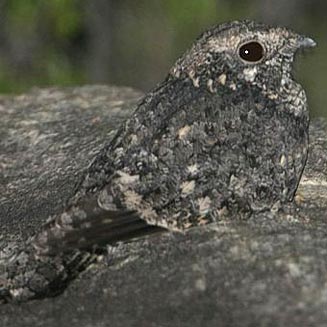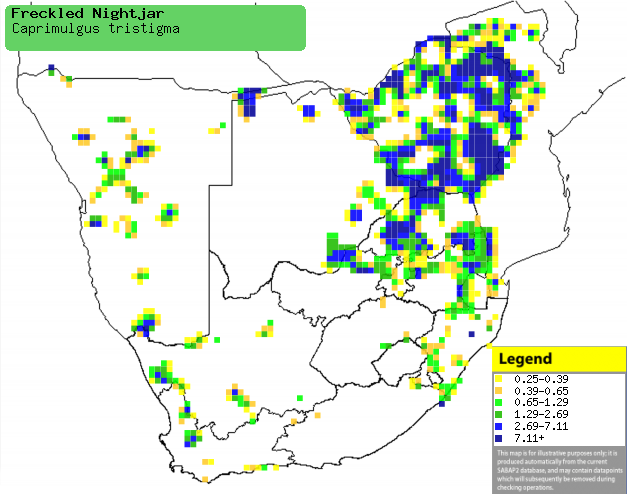|
Caprimulgus tristigma (Freckled
nightjar)
Donkernaguil [Afrikaans]; Datiwa (generic name for
nightjar) [Shona]; Mahulwana, Ribyatsane, Riwuvawuva (generic terms for nighjar)
[Tsonga]; Leubauba, Mmapheke, Tshogwi (all 3 are generic terms for nightjar)
[Tswana]; Rotsnachtzwaluw [Dutch]; Engoulevent pointillé [French];
Fleckennachtschwalbe [German]; Noitibó-sardento [Portuguese]
Life
> Eukaryotes >
Opisthokonta
> Metazoa (animals) >
Bilateria >
Deuterostomia > Chordata >
Craniata > Vertebrata (vertebrates) > Gnathostomata (jawed
vertebrates) > Teleostomi (teleost fish) > Osteichthyes (bony fish) > Class:
Sarcopterygii (lobe-finned
fish) > Stegocephalia (terrestrial
vertebrates) > Tetrapoda
(four-legged vertebrates) > Reptiliomorpha > Amniota >
Reptilia (reptiles) >
Romeriida > Diapsida > Archosauromorpha > Archosauria >
Dinosauria
(dinosaurs) > Saurischia > Theropoda (bipedal predatory dinosaurs) >
Coelurosauria > Maniraptora > Aves
(birds) > Order: Strigiformes > Family: Caprimulgidae
 |
|
|
Freckled nightjar, Klipbokkop Mountain Lodge,
South Africa. [photo Trevor Hardaker ©] |
|
The Freckled nightjar occurs in localized populations across
sub-Saharan Africa, from Guinea to Ethiopia south to southern Africa. Here it is
scarce in the western half of the region, but is however much more common in the
eastern Half, especially in Zimbabwe. It roosts and nests on rocks, and can
actually tolerate surface temperatures of 60 degrees centigrade! It feeds mainly
on beetles and moths, and has the largest gape of any nightjar, and is capable
of swallowing 3.5 cm long insects whole. It nests in natural hollows in rocks,
where it lays 2 eggs, which are incubated for 18-20 days by both sexes. The
chicks are cared for by both parents, and are camouflaged so that they blend in
with the surrounding rock.
Distribution and habitat
Occurs in localized populations
across sub-Saharan Africa, from Guinea to Ethiopia south to southern Africa.
Within southern Africa it is scarce in central Namibia and the Northern and
Western Cape, while more common in northern and eastern Botswana, Zimbabwe,
western Mozambique and eastern South Africa. It generally prefers areas with lots of rock formations
or boulders, such as rocky hillsides, ravines, escarpments and rock-strewn dry
riverbeds, often with adjacent broad-leaved woodland. It roosts and nests on rocks, and
can actually tolerate surface temperatures of 60 degrees celsius!
|
 |
|
Distribution of Freckled nightjar in southern Africa,
based on statistical smoothing of the records from first SA Bird Atlas
Project (©
Animal Demography unit, University of
Cape Town; smoothing by Birgit Erni and Francesca Little). Colours range
from dark blue (most common) through to yellow (least common).
See here for the latest distribution
from the SABAP2. |
Food
Feeds mainly on
beetles and moths, doing its foraging at dusk, dawn and sometimes moonlit
nights. It has the largest gape of any nightjar, and is capable of swallowing
3.5 cm long insects whole. It mainly forages in woodland, hunting from the ground
and making repeated forays into the night. It hawks insects aerially before
returning to the same spot. The following food items have been recorded in its
diet:
Breeding
- It nests in bare, natural hollows in rock, often filled
with wind blown debris such as rock chips and leaves.
- In the eastern half of southern Africa the egg-laying season is from
August-December, peaking from September-November, however there is no data
for Namibia and the Western Cape.
- It lays two eggs, which are incubated by both sexes for 18-20 days: the
female incubates in the daytime, while the male takes the night shift.
- The chicks are extremely well camouflaged, as they are covered in dark
grey down mottled with white, blending in with the surrounding rock. They
are cared for by both parents; the female broods them during the day and
both parents hunt at night. The chicks take
their first flight at about 19-20 days old.
Threats
Not threatened.
References
-
Hockey PAR, Dean WRJ and Ryan PG (eds) 2005. Roberts -
Birds of southern Africa, VIIth ed. The Trustees of the John Voelcker
Bird Book Fund, Cape Town.
|
